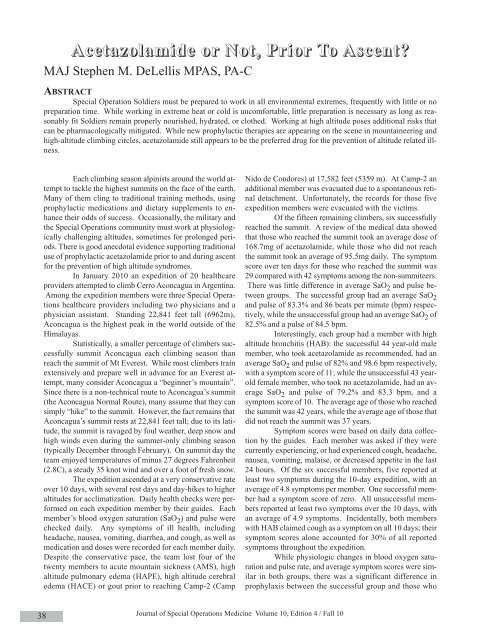Fall - United States Special Operations Command
Fall - United States Special Operations Command
Fall - United States Special Operations Command
Create successful ePaper yourself
Turn your PDF publications into a flip-book with our unique Google optimized e-Paper software.
38<br />
Acetazolamide or Not, Prior To Ascent?<br />
MAJ Stephen M. DeLellis MPAS, PA-C<br />
ABSTRACT<br />
<strong>Special</strong> Operation Soldiers must be prepared to work in all environmental extremes, frequently with little or no<br />
preparation time. While working in extreme heat or cold is uncomfortable, little preparation is necessary as long as reasonably<br />
fit Soldiers remain properly nourished, hydrated, or clothed. Working at high altitude poses additional risks that<br />
can be pharmacologically mitigated. While new prophylactic therapies are appearing on the scene in mountaineering and<br />
high-altitude climbing circles, acetazolamide still appears to be the preferred drug for the prevention of altitude related illness.<br />
Each climbing season alpinists around the world attempt<br />
to tackle the highest summits on the face of the earth.<br />
Many of them cling to traditional training methods, using<br />
prophylactic medications and dietary supplements to enhance<br />
their odds of success. Occasionally, the military and<br />
the <strong>Special</strong> <strong>Operations</strong> community must work at physiologically<br />
challenging altitudes, sometimes for prolonged periods.<br />
There is good anecdotal evidence supporting traditional<br />
use of prophylactic acetazolamide prior to and during ascent<br />
for the prevention of high altitude syndromes.<br />
In January 2010 an expedition of 20 healthcare<br />
providers attempted to climb Cerro Aconcagua in Argentina.<br />
Among the expedition members were three <strong>Special</strong> <strong>Operations</strong><br />
healthcare providers including two physicians and a<br />
physician assistant. Standing 22,841 feet tall (6962m),<br />
Aconcagua is the highest peak in the world outside of the<br />
Himalayas.<br />
Statistically, a smaller percentage of climbers successfully<br />
summit Aconcagua each climbing season than<br />
reach the summit of Mt Everest. While most climbers train<br />
extensively and prepare well in advance for an Everest attempt,<br />
many consider Aconcagua a “beginner’s mountain”.<br />
Since there is a non-technical route to Aconcagua’s summit<br />
(the Aconcagua Normal Route), many assume that they can<br />
simply “hike” to the summit. However, the fact remains that<br />
Aconcagua’s summit rests at 22,841 feet tall; due to its latitude,<br />
the summit is ravaged by foul weather, deep snow and<br />
high winds even during the summer-only climbing season<br />
(typically December through February). On summit day the<br />
team enjoyed temperatures of minus 27 degrees Fahrenheit<br />
(2.8C), a steady 35 knot wind and over a foot of fresh snow.<br />
The expedition ascended at a very conservative rate<br />
over 10 days, with several rest days and day-hikes to higher<br />
altitudes for acclimatization. Daily health checks were performed<br />
on each expedition member by their guides. Each<br />
member’s blood oxygen saturation (SaO 2 ) and pulse were<br />
checked daily. Any symptoms of ill health, including<br />
headache, nausea, vomiting, diarrhea, and cough, as well as<br />
medication and doses were recorded for each member daily.<br />
Despite the conservative pace, the team lost four of the<br />
twenty members to acute mountain sickness (AMS), high<br />
altitude pulmonary edema (HAPE), high altitude cerebral<br />
edema (HACE) or gout prior to reaching Camp-2 (Camp<br />
Nido de Condores) at 17,582 feet (5359 m). At Camp-2 an<br />
additional member was evacuated due to a spontaneous retinal<br />
detachment. Unfortunately, the records for those five<br />
expedition members were evacuated with the victims.<br />
Of the fifteen remaining climbers, six successfully<br />
reached the summit. A review of the medical data showed<br />
that those who reached the summit took an average dose of<br />
168.7mg of acetazolamide, while those who did not reach<br />
the summit took an average of 95.5mg daily. The symptom<br />
score over ten days for those who reached the summit was<br />
29 compared with 42 symptoms among the non-summiteers.<br />
There was little difference in average SaO 2 and pulse between<br />
groups. The successful group had an average SaO 2<br />
and pulse of 83.3% and 86 beats per minute (bpm) respectively,<br />
while the unsuccessful group had an average SaO 2 of<br />
82.5% and a pulse of 84.5 bpm.<br />
Interestingly, each group had a member with high<br />
altitude bronchitis (HAB): the successful 44 year-old male<br />
member, who took acetazolamide as recommended, had an<br />
average SaO 2 and pulse of 82% and 98.6 bpm respectively,<br />
with a symptom score of 11; while the unsuccessful 43 yearold<br />
female member, who took no acetazolamide, had an average<br />
SaO 2 and pulse of 79.2% and 83.3 bpm, and a<br />
symptom score of 10. The average age of those who reached<br />
the summit was 42 years, while the average age of those that<br />
did not reach the summit was 37 years.<br />
Symptom scores were based on daily data collection<br />
by the guides. Each member was asked if they were<br />
currently experiencing, or had experienced cough, headache,<br />
nausea, vomiting, malaise, or decreased appetite in the last<br />
24 hours. Of the six successful members, five reported at<br />
least two symptoms during the 10-day expedition, with an<br />
average of 4.8 symptoms per member. One successful member<br />
had a symptom score of zero. All unsuccessful members<br />
reported at least two symptoms over the 10 days, with<br />
an average of 4.9 symptoms. Incidentally, both members<br />
with HAB claimed cough as a symptom on all 10 days; their<br />
symptom scores alone accounted for 30% of all reported<br />
symptoms throughout the expedition.<br />
While physiologic changes in blood oxygen saturation<br />
and pulse rate, and average symptom scores were similar<br />
in both groups, there was a significant difference in<br />
prophylaxis between the successful group and those who<br />
Journal of <strong>Special</strong> <strong>Operations</strong> Medicine Volume 10, Edition 4 / <strong>Fall</strong> 10

















